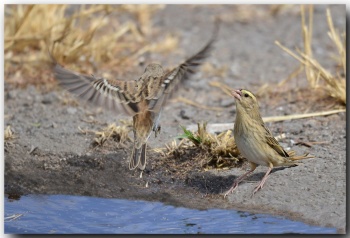Alternative name: Emin Bey's Sparrow
- Passer eminibey
Identification
10.5 - 11.5cm (4-4½ in)
Male
- Dark chestnut plumage, darker and browner on face
- Blackish-brown wing and tail with chestnut edges
- Dark brown eye
- Blackish bill
- Pale brown legs
Female

Photo © by volker sthamer
Burunge, Tanzania, September 2017
- Grey-brown head to upper mantle
- Chestnut-buff supercilium
- Chestnut centre of throat and chin
- Chestnut-brown lower mantle
- Streaked dark brown scapulars
- More rufous back to uppertail-coverts
- Wings and tail like male but paler and buffer edges
- Dull chestnut chest becoming buff on belly and flanks
- Paler bill than male
Juveniles are similar to females but paler.
Distribution
Found in central Chad, southwestern Sudan, South Sudan, and southwestern Ethiopia to northeastern Uganda, Kenya, and central and eastern Tanzania.
Common but local.
Taxonomy
This is a monotypic species[1].
Has originally been placed in its own genus Sorella.
Habitat
Dry acacia savanna, often near swamps and human habitation. Occurs up to 2200m.
Behaviour
Diet
Feeds on seeds of grasses and weeds. Nestlings are fed with insects.
Forages mostly in small groups on the ground.
Breeding
The breeding season coincides with rains and can take place at any time of year. A colonial breeder, sometimes in singe-species colonies but often in mixed ccolonies with Speke's Weaver, Lesser Masked Weaver and/or Grey-capped Social Weaver. The nest is an untidy globe with a side entrance made of grass. It's placed in a tree, often in an old nest of a Weaver. Also ejects original owner of the nest to take it over. Lays 3 - 4 eggs.
Movements
A nomadic species.
Gallery
Click on photo for larger image
Group
Photo © by Valéry Schollaert
d'Arusha, Tanzania, September 2010
References
- Clements, J. F., T. S. Schulenberg, M. J. Iliff, D. Roberson, T. A. Fredericks, B. L. Sullivan, and C. L. Wood. 2018. The eBird/Clements checklist of birds of the world: v2018. Downloaded from http://www.birds.cornell.edu/clementschecklist/download/
- Del Hoyo, J, A Elliott, and D Christie, eds. 2009. Handbook of the Birds of the World. Volume 14: Bush-shrikes to Old World Sparrows. Barcelona: Lynx Edicions. ISBN 978-8496553507
Recommended Citation
- BirdForum Opus contributors. (2024) Chestnut Sparrow. In: BirdForum, the forum for wild birds and birding. Retrieved 26 April 2024 from https://www.birdforum.net/opus/Chestnut_Sparrow







